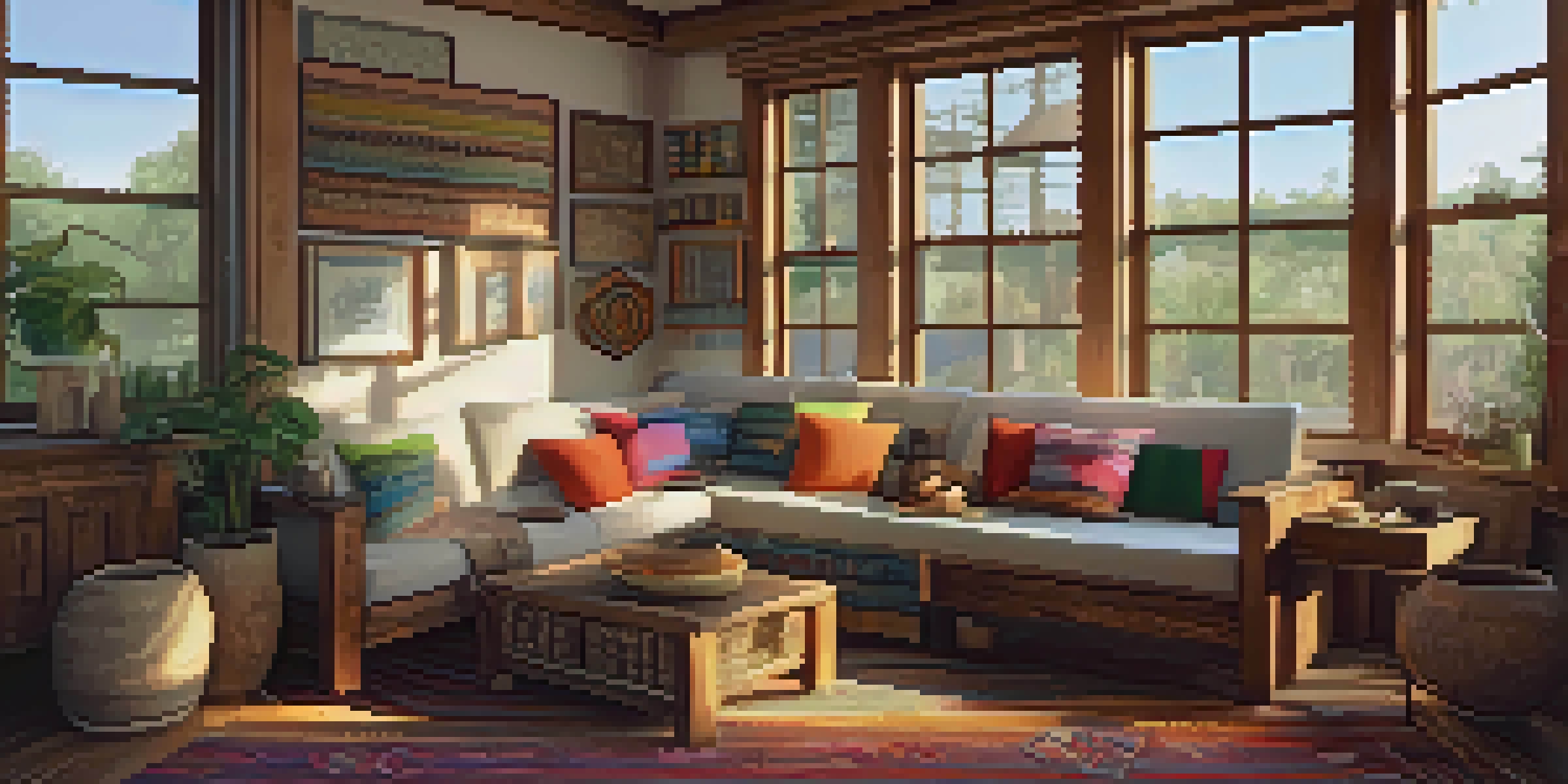Utilizing Local Resources in Home Design

Understanding the Importance of Local Resources in Design
Utilizing local resources in home design not only supports the community but also promotes sustainability. By sourcing materials and services from nearby suppliers, you reduce transportation emissions and foster economic growth in your area. This approach allows homeowners to create spaces that reflect their local culture and environment, making their homes more unique and personal.
The greatness of a community is most accurately measured by the compassionate actions of its members.
Think about it: when you use local stone, wood, or artisans, you’re not just building a home; you're telling a story that resonates with your surroundings. For instance, a house built with reclaimed wood from a local barn carries history and character that new materials simply can’t match. This connection to the locale infuses your home with a sense of belonging and authenticity.
Moreover, local resources often come with the added benefit of higher quality. Local artisans take pride in their work and often use techniques passed down through generations. This can result in a finished product that is not only beautiful but also built to stand the test of time.
Finding Local Suppliers and Artisans
The first step in utilizing local resources is identifying suppliers and artisans in your area. A simple online search can yield a wealth of options, from lumber yards to local craftspeople who specialize in custom furniture. Additionally, platforms like social media can help you discover local talent and businesses that align with your design vision.

Don’t hesitate to visit local markets or trade shows where artisans showcase their work. Such events provide an excellent opportunity to meet the creators behind the products and get a feel for their craftsmanship. Plus, you can often negotiate better deals when you buy directly from the source.
Support Local for Unique Homes
Utilizing local resources in home design not only enhances sustainability but also creates spaces that reflect your community's culture.
Building relationships with these suppliers can also lead to valuable insights about the materials and techniques best suited for your design. They can offer advice on which resources are sustainable and durable, ensuring that your home is not only beautiful but also functional.
Incorporating Local Materials into Your Design
Once you've identified local resources, the next step is to thoughtfully incorporate them into your design. Consider using local stone for your home's foundation or facade; it adds a natural aesthetic and blends seamlessly with the surrounding landscape. Similarly, local hardwoods can be used for flooring or cabinetry, bringing warmth and richness to your interiors.
Sustainability is not a destination; it’s a journey. Each choice we make is a step toward a healthier planet.
Another great idea is to incorporate local textiles into your decor. Fabrics woven by local artisans can add unique patterns and colors, setting the tone for a cozy and inviting space. Imagine draping a handwoven throw over your couch, instantly adding character and supporting local craftsmanship.
Additionally, using native plants in your landscaping not only enhances the beauty of your home but also promotes biodiversity. Native plants are often more resilient and require less maintenance, making them a practical choice for homeowners looking to reduce their environmental footprint.
Designing for Energy Efficiency with Local Resources
Local resources can also play a crucial role in enhancing the energy efficiency of your home. By sourcing materials that are naturally insulating, like straw bales or rammed earth, you can reduce your reliance on artificial heating and cooling systems. This not only cuts down on energy bills but also minimizes your overall environmental impact.
Incorporating local renewable energy sources, like solar panels or wind turbines, is another way to enhance sustainability. Many local companies offer tailored solutions that reflect your home’s specific needs and your region's climate. Embracing these technologies supports local businesses while promoting a greener lifestyle.
Enhance Energy Efficiency Locally
Sourcing local materials and renewable energy solutions can significantly improve your home's energy efficiency and reduce environmental impact.
Moreover, designing your home to take advantage of local climate conditions—such as positioning windows to maximize natural light or creating overhangs for shade—can significantly improve energy efficiency. This thoughtful integration of local resources and knowledge creates a home that is both comfortable and eco-friendly.
Creating a Sense of Community Through Local Design
Utilizing local resources in home design fosters a sense of community and connection. When you support local businesses, you’re contributing to the livelihood of your neighbors and helping to build a vibrant local economy. This sense of shared purpose can enhance your own sense of belonging in the community.
Moreover, homes designed with local elements often reflect the architectural styles and traditions of the area, creating a cohesive aesthetic throughout neighborhoods. This not only beautifies the landscape but also encourages pride among residents, as their homes tell a shared story.
Engaging with local artisans and suppliers can also spark collaborative projects within the community. For instance, a group of homeowners might come together to commission a local artist to create a public mural, further enriching the local culture and enhancing everyone's enjoyment of their surroundings.
Sustainable Practices in Home Design
Sustainable practices are at the heart of utilizing local resources in home design. When you choose materials that are sourced sustainably, you're making a commitment to the environment and future generations. This can include selecting reclaimed materials, which not only reduces waste but also adds character to your home.
Additionally, consider implementing passive design strategies that rely on local climate and resources. For example, orienting your home to capture prevailing winds for natural ventilation can reduce the need for air conditioning. Simple design tweaks can significantly enhance comfort while minimizing energy use.
Foster Community Through Design
Incorporating local elements in design fosters a sense of community and connection, enhancing pride and collaboration among neighbors.
Finally, always keep an eye on your long-term impact. Regular maintenance of local materials ensures their longevity, which means you won’t have to replace them often, reducing waste and resource consumption over time. Sustainable home design is a journey that starts with thoughtful choices.
Showcasing Local Culture Through Design Choices
Home design is a beautiful way to showcase local culture and heritage. By incorporating elements that reflect the history or artistic style of your region, you create a space that celebrates your community's uniqueness. This could be as simple as using local pottery or artwork in your decor.
Consider also highlighting architectural features that are traditional to your area. Whether it's a specific roof style, window design, or building material, these elements can help your home blend seamlessly into the landscape while paying homage to local building practices.

Moreover, participating in local design trends can create a dialogue with your neighbors and visitors. Hosting an open house to share your design journey and the local resources you’ve used can inspire others to do the same, creating a ripple effect of community engagement and appreciation.